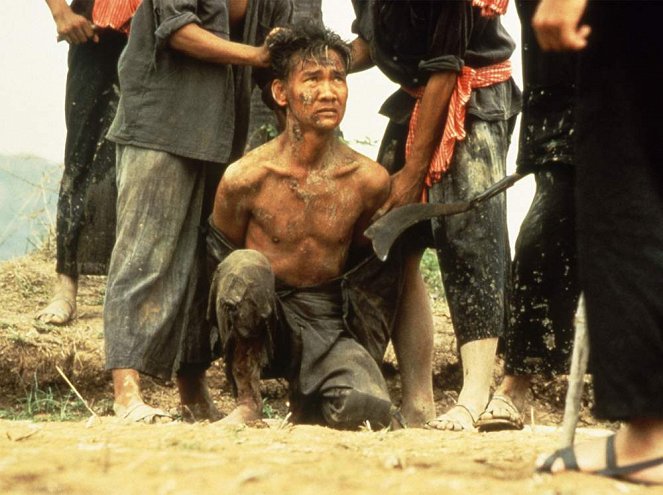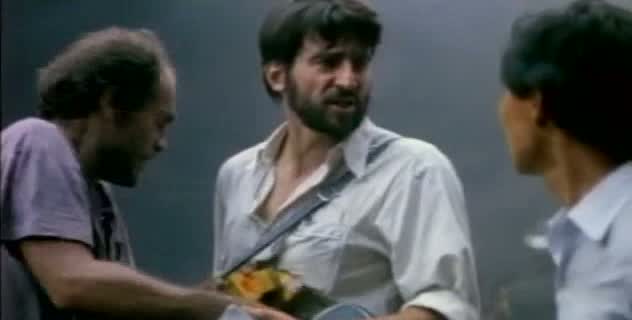Directed by:
Roland JofféScreenplay:
Bruce RobinsonCinematography:
Chris MengesComposer:
Mike OldfieldCast:
Sam Waterston, Haing S. Ngor, John Malkovich, Julian Sands, Craig T. Nelson, Spalding Gray, Bill Paterson, Athol Fugard, Mark Long, Patrick Malahide (more)Plots(1)
The Killing Fields is a romanticized adaptation of an eyewitness magazine story by New York Times correspondent Sidney Schanberg. Covering the U.S. pullout from Vietnam in 1975, Schanberg (Sam Waterston) relies on his Cambodian friend and translator Dith Pran (Haing S. Ngor) for inside information. Schanberg has an opportunity to rescue Dith Pran when the U.S. army evacuates all Cambodian citizens; instead, the reporter coerces his friend to remain behind to continue sending him news flashes. Although his family is helicoptered out of Saigon (a recreation of the famous TV news clip), Dith Pran stays with Schanberg on the ground. Racked with guilt, Schanberg does his best to arrange for Dith Pran's escape, but the Cambodian is captured by the dreaded Khmer Rouge. Accepting his Pulitzer Prize on behalf of Dith Pran, Schanberg vows to do right by his friend and extricate him from Cambodia. The rest of the film details Dith Pran's harrowing experiences at the hands of the Khmer Rouge, and his attempt to escape on his own. (Umbrella Entertainment)
(more)Videos (1)
Reviews (9)
How is it possible that such powerful content can be expressed through masterful form? With this film, a picture often says more than a few thousand words. Rather than an uncompromising anti-communist agitprop, The Killing Fields is a gripping story about the distressing reunion of two lifelong friends. With great distinctiveness and candor, the first half skillfully captures the disarray of a state affected by the clenched fist of the communist revolution. The second half then shows with what coldness the social stratum of intelligence can be liquidated. The relentlessness of the labor camp, from which there is essentially no escape, then escalates into horrifying images dominated by a little girl with a blue plastic bag, and the subsequent transition to the "killing field." The ending becomes even more powerful and emotional, causing even the toughest person to momentarily forget their toughness and be deeply moved.
()
Although it’s rather misleading that historical films of this kind receive high ratings automatically and partly because they exist, this morally worthy and emotionally charged gem basks in praise, and rightly so. It’s very painful to see all the heinous acts that people are capable of doing to others, and it’s even more painful with the virtuoso Roland Joffé, the famous creator of the no less appealing, artistically intoxicating The Mission, behind the camera. He was able to materialize the atmosphere of occupied Cambodia, the conflict of the power of love and friendship with pure human suffering and the unadulterated joy at the moment when John Lennon launched his "Imagine" so perfectly that I could almost say "yes, I was there". So, yes, this film deserves all the high ratings, simply because it exists. 95%
()
There is nothing difficult to understand about the premise of this film. The main motive is the friendship of a professional journalist who tries to map the events in Cambodia and a local who takes him around this mysterious and beautiful country. Unfortunately, at a time when the Khmer Rouge are trying to seize the government. A story that only real life could have written. When we add in the precise camera and the fact that the Khmers carried out purges that would make even Hitler green with envy, trust me it’s not a pleasant viewing experience. The first half lets you navigate yourself in the events, but the second shows true evil. It baffled me that anyone would participate in such atrocities. It was horrifying, not only visually in some scenes but also in terms of the psychology of certain characters. It’s been a long time since I spent two hours just gaping at some film in total stupor.
()
The first half of the film wasn't uninteresting and I can't say that nothing happened in it, but compared to the second half it was really weak and overly ordinary. I also have some reservations about Oldfield's music, which fits the plot like a glove in places (quiet passages or the dramatic evacuation), but at other times it sticks out and distracts from the film (the captivity of the journalists, for example). As I've already said, everything that is worth seeing in the film happens in the second half - Dit Pran wanders Cambodia (here Rolland Joffé was obviously preparing for the upcoming Mission), Schanberg watches TV at home with Vincero playing, Schanberg searches for Pran... And then, of course, the beautiful ending (of course I feel bad for Lennon). Three and a half.
()
At first, it seems like just a great performance by Sam Waterston, but this film develops incredibly until you reach the point where it's an immensely powerful drama, both socially and humanly. War is depicted here without embellishments, yet most of the time, we're not even on the battlefield. The impact on the viewer who sees the result is even greater.
()
Gallery (77)
Photo © Warner Bros. Pictures



Ads